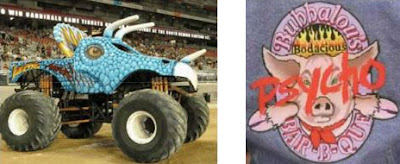Precedential No. 13: TTAB Reverses Mutilation and Phantom Mark Refusals of U. Miami Ibis Design
The Board reversed two refusals to register the mark shown below, for various paper products, clothing, and educational and entertainment services, finding that it comprised neither a mutilation of the mark as actually used, nor a phantom mark. The applied-for mark, which "consists of an ibis wearing a hat and a sweater," depicts the mascot of the University of Miami, Sebastian the Ibis. In re University of Miami, 123 USPQ2d 1075 (TTAB 2017) [precedential] (Opinion by Judge Hightower).
Mutilation: Section 1051(a)(1) of the Trademark Act requires that an applicant submit a specimen of its mark as used. An applicant must also submit a drawing that is a "substantially exact representation of the mark" as used. See Rule 2.51(a). If the mark in the drawing contains only a minor alteration of the mark as used - i.e., it does not create an different commercial impression than the mark as used - the drawing is acceptable.
Here the mark in the drawing (above) differed from the mark as used (example below) in several ways: in use, the stylized letter "U" appears in the center of the hat; the word "Miami" is displayed on the front of the sweater; and the sweater has striping along the side and shoulders.
The Board noted that the Examining Attorney contended, in effect, that applicant has mutilated its mark by "severing part of it and seeking registration of only that part." The question for the Board was this: "What exactly is the 'trademark,' and does the designation for which registration is sought comprise a separate and distinct 'trademark' in and of itself?"
The Board observed that an applicant is allowed some latitude in selecting the mark that it wants to register, as long as the portion it selects creates a separate and distinct commercial impression. If not, the result is an impermissible mutilation of an Ibis.
The Board pointed to several prior decisions as examples of a design or word being registrable separate from accompanying matter, including a monster truck design without the words JURASSIC ATTACK appearing on the vehicle, the word PSYCHO apart from accompanying words and design, and the design of a bear inside a container separate from the word STERNO appearing thereon:
In light of those prior decisions, the Board found that the applied-for design mark creates a separate and distinct commercial impression from the letter "U" and the word "Miami" that appear on the specimens of use. Despite the appearance of that text, "the overall display on the specimens creates the commercial impression of a personified ibis."
As to the stripes on the sweater, the Board found their absence to be a minor alteration (like the stylized gills or strips in the monster truck case) that does not create a different mark with a different commercial impression from that of the specimens.
And so the Board found that applicant's drawing is a substantially exact representation of applicant's mark as actually used, and it reversed this refusal to register.
Phantom Mark: The Examining Attorney further contended that applicant was attempting to register more than one mark because the sweater "operates as a blank slate for whatever additional elements the applicant, in its sole discretion, sees fit to include."
The Board noted that under the Trademark Act an applicant may seek to register only a single mark, and a mark that includes a changeable or phantom element constitutes more than one mark. Registration of phantom marks is prohibited because "they do not disclose the designation used to identify and distinguish the goods covered by the mark, which makes it impossible to conduct an effective search."
Here, neither the drawing nor the mark description ("The mark consists of an ibis wearing a hat and a sweater") identifies a changeable or missing element. The refusal arose because of the extra elements that appear within the ibis design on the specimens of use. However, these extra elements are not "integral to Applicant's mark."
Applicant claims no rights to any wording in either the drawing or the mark description. We do not find Dial-A-Mattress to be on point here because Applicant has not applied to register a series of marks, or a mark with dashes or a blank space reserved for a term; rather, the applied-for mark incorporates no wording whatsoever. A registration of the ibis design covers only that mark as shown on the drawing, not any house marks or other literal elements Applicant chooses to add to it.
In short, applicant has not applied to register multiple marks. And so the Board reversed the phantom mark refusal.
Read comments and post your comment here.
TTABlog comment: This case suggests a way to avoid a phantom mark refusal: don't claim the phantom element as part of the mark, but in actual use set off the non-phantom element in such a way that it creates a separate commercial impression (e.g, by font, color, or design).
Text Copyright John L. Welch 2017.








2 Comments:
I don't know if I agree with this one. At least the stripes on the sweater should be considered as part of the mark.
The EA's argument on phantom was self-defeating (the sweater "operates as a blank slate for whatever additional elements the applicant, in its sole discretion, sees fit to include").
That's exactly right. The mark is registrable regardless of what's on the sweater. That's why it's a separate mark.
Post a Comment
<< Home